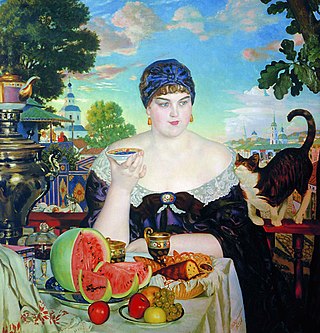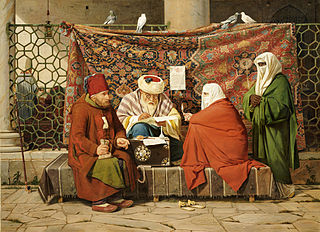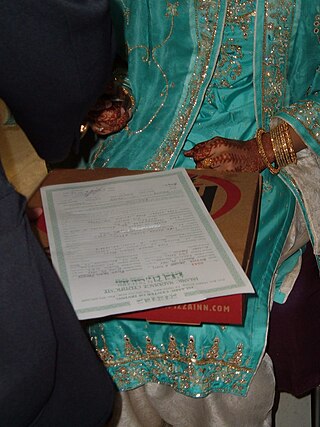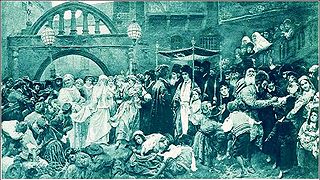Marriage, also called matrimony or wedlock, is a culturally and often legally recognised union between people called spouses. It establishes rights and obligations between them, as well as between them and their children, and between them and their in-laws. It is nearly a cultural universal, but the definition of marriage varies between cultures and religions, and over time. Marriage becomes a social construct to adjudicate the conflicts of interest between consenting individuals and a transactional means to fulfill their needs. Typically, it is an institution in which interpersonal relationships, usually sexual, are acknowledged or sanctioned. In some cultures, marriage is recommended or considered to be compulsory before pursuing sexual activity. A marriage ceremony is called a wedding, while a private marriage is sometimes called an elopement.

A wife is a woman in a marital relationship. A woman who has separated from her partner continues to be a wife until their marriage is legally dissolved with a divorce judgment. On the death of her partner, a wife is referred to as a widow. The rights and obligations of a wife to her partner and her status in the community and law vary between cultures and have varied over time.
A dowry is a payment, such as property or money, paid by the bride's family to the groom or his family at the time of marriage. Dowry contrasts with the related concepts of bride price and dower. While bride price or bride service is a payment by the groom, or his family, to the bride, or her family, dowry is the wealth transferred from the bride, or her family, to the groom, or his family. Similarly, dower is the property settled on the bride herself, by the groom at the time of marriage, and which remains under her ownership and control.
In Islam, a mahr is the bride wealth obligation, in the form of money, possessions or teaching of verses from the Quran by the groom, to the bride at the time of the Islamic Wedding. While the mahr is often money, it can also be anything agreed upon by the bride such as jewelry, home goods, furniture, a dwelling or some land. Mahr is typically specified in the marriage contract signed upon marriage.

In Islam, nikah is a contract exclusively between a man and woman. Both the groom and the bride are to consent to the marriage of their own free wills. A formal, binding contract – verbal or on paper – is considered integral to a religiously valid Islamic marriage, and outlines the rights and responsibilities of the groom and bride. Divorce in Islam can take a variety of forms, some executed by a husband personally and some executed by a religious court on behalf of a plaintiff wife who is successful in her legal divorce petition for valid cause. Islamic marital jurisprudence allows Muslim men to be married to multiple women.

A ketubah is a Jewish marriage contract. It is considered an integral part of a traditional Jewish marriage, and outlines the rights and responsibilities of the groom, in relation to the bride. In modern practice, the ketubah has no agreed monetary value, and is seldom enforced by civil courts, except in Israel.

Traditional Chinese marriage is a ceremonial ritual within Chinese societies that involves not only a union between spouses but also a union between the two families of a man and a woman, sometimes established by pre-arrangement between families. Marriage and family are inextricably linked, which involves the interests of both families. Within Chinese culture, romantic love and monogamy were the norm for most citizens. Around the end of primitive society, traditional Chinese marriage rituals were formed, with deer skin betrothal in the Fuxi era, the appearance of the "meeting hall" during the Xia and Shang dynasties, and then in the Zhou dynasty, a complete set of marriage etiquette gradually formed. The richness of this series of rituals proves the importance the ancients attached to marriage. In addition to the unique nature of the "three letters and six rituals", monogamy, remarriage and divorce in traditional Chinese marriage culture are also distinctive.

An Islamic marriage contract is considered an integral part of an Islamic marriage, and outlines the rights and responsibilities of the husband and wife or other parties involved in marriage proceedings under Sharia. Whether it is considered a formal, binding contract depends on the jurisdiction. Islamic faith marriage contracts are not valid in English law, nor American Law. Because of this, some Islamic Marriage Officiants will only officiate a marriage after the couple had been legally married in court.

Dower is a provision accorded traditionally by a husband or his family, to a wife for her support should she become widowed. It was settled on the bride by agreement at the time of the wedding, or as provided by law.
Lobolo or lobola in Zulu, Xhosa, Swazi, Silozi, Shona and northern and southern Ndebele, sometimes referred to as "bride wealth" or "bride price" is a property in livestock or kind, which a prospective husband, or head of his family, undertakes to give to the head of a prospective wife's family in gratitude of letting the husband marry their daughter and for them brides family for raising her.

A Jewish wedding is a wedding ceremony that follows Jewish laws and traditions. While wedding ceremonies vary, common features of a Jewish wedding include a ketubah which is signed by two witnesses, a chuppah or huppah, a ring owned by the groom that is given to the bride under the canopy, and the breaking of a glass.
Chinese pre-wedding customs are traditional Chinese rituals prescribed by the 禮記 (láih gei, the 儀禮 (yìh láih and the 白虎通 condensed into a series of rituals now known as the 三書六禮. Traditionally speaking, a wedding that incorporates all six rites is considered a daaih chéui.
In the United States and Canada, weddings follow traditions often based on religion, culture, and social norms. Most wedding traditions in the United States and Canada were assimilated from other, generally European, countries. Marriages in the U.S. and Canada are typically arranged by the participants and ceremonies may either be religious or civil. There is a tradition that the prospective bridegroom ask his future father-in-law for his blessing.

Erusin is the Hebrew term for betrothal. In modern Hebrew, "erusin" means engagement, but this is not the historical meaning of the term, which is the first part of marriage.

Muslim marriage and Islamic wedding customs are traditions and practices that relate to wedding ceremonies and marriage rituals prevailing within the Muslim world. Although Islamic marriage customs and relations vary depending on country of origin and government regulations, both Muslim men and women from around the world are guided by Islamic laws and practices specified in the Quran. Islamic marital jurisprudence allows Muslim men to be married to multiple women.
Arranged marriage is a type of marital union where the bride and groom are primarily selected by individuals other than the couple themselves, particularly by family members such as the parents. In some cultures, a professional matchmaker may be used to find a spouse for a young person.
The dowry system in India refers to the durable goods, cash, and real or movable property that the bride's family gives to the groom, his parents and his relatives as a condition of the marriage. Dowry is called "दहेज" in Hindi and as جہیز in Urdu.
Wedding customs in Ethiopia vary among the tribes of the country.
Marriage ceremonies within Africa vary greatly between countries due to the diversity of culture and religion throughout the continent. Africa has a population of over 1.4 billion people spread throughout 54 countries. The large size and extreme diversity of the continent leads to enormous diversity among the marriage ceremonies and traditions that take place. Marriage ceremonies throughout Africa vary greatly depending on the faith of the individuals. The World Book Encyclopedia states that 40% of Africans identify as Christian while 45% are Muslim.










